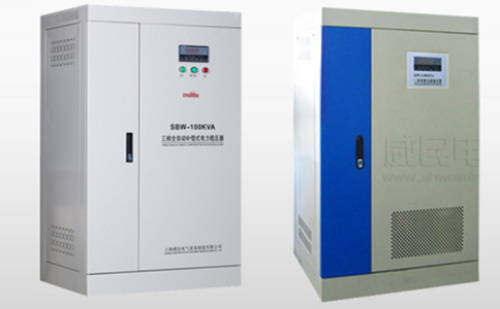
Introduction: Transformers are devices that convert alternating voltages, currents, and impedances. When an alternating current flows in the primary coil, an alternating magnetic flux is generated in the core (or core), which induces a voltage (or current) in the secondary coil. . The transformer consists of a core (or core) and a coil, and the coil has two or more windings, wherein the winding of the power supply is called the primary coil and the rest of the winding is called the secondary coil.
First, the principle of transformer production:
In a generator, whether the coil moves through a fixed coil through a magnetic field or a magnetic field, a potential can be induced in the coil. In both cases, the value of the magnetic flux does not change, but the amount of magnetic flux that intersects the coil has Change, this is the principle of mutual induction. A transformer is a device that uses electromagnetic induction to convert voltage, current, and impedance.
Second, classification
Classified by cooling method: dry (self-cooling) transformers, oil-immersed (self-cooling) transformers, and fluoride (evaporative cooling) transformers. According to moisture classification: open transformers, potted transformers, sealed transformers.
According to core or coil structure classification: core type transformer (insert core, C type core, ferrite core), shell type transformer (insert core, C type core, ferrite core), Toroidal transformers, metal foil transformers.
According to the number of phases of the power supply: single-phase transformers, three-phase transformers, multi-phase transformers.
Classified by purpose: power transformers, regulator transformers, audio transformers, intermediate frequency transformers, high frequency transformers, pulse transformers.
Third, the characteristics of power transformer parameters
The working frequency transformer core loss and frequency is very large, so it should be designed and used according to the frequency of use, this frequency is called the operating frequency.
Rated power at a specified frequency and voltage, the transformer can work long-term, without exceeding the output power of the specified temperature rise.
The rated voltage refers to the allowable voltage applied to the coil of the transformer and must not exceed the specified value during operation.
The voltage ratio refers to the ratio of the transformer primary voltage to the secondary voltage, with the difference between the no-load voltage ratio and the load voltage ratio.
When the no-load current transformer is open, the primary still has a certain current. This part of the current is called the no-load current. The no-load current consists of a magnetizing current (flux producing) and an iron loss current (caused by the core loss). For a 50Hz power transformer, the no-load current is substantially equal to the magnetizing current.
No-load loss refers to the power loss measured at the primary when the transformer secondary is open. The main loss is the core loss, followed by the loss (copper loss) of the no-load current on the copper resistance of the primary coil. This part of the loss is very small.
Efficiency refers to the percentage of the ratio of secondary power P2 to primary power P1. In general, the higher the rated power of the transformer, the higher the efficiency.
The insulation resistance represents the insulation performance between the coils of the transformer and between the coils and the iron core. The level of insulation resistance is related to the performance of the insulating material used, the temperature and the degree of humidity.
Asbestos was added as an common ingredient to Brake Pads post-WWI, as car speeds began to increase, because research showed that its properties allowed it to absorb the heat (which can reach 500 °F) while still providing the friction necessary to stop a vehicle. However, as the serious health-related hazards of asbestos eventually started to become apparent, other materials had to be found. Asbestos brake pads have largely been replaced by non-asbestos organic (NAO) materials in first world countries. Today, brake pad materials are classified into one of four principal categories, as follows:
Non-metallic materials - these are made from a combination of various synthetic substances bonded into a composite, principally in the form of cellulose, aramid, PAN, and sintered glass. They are gentle on rotors, but produce a fair amount of dust, thus having a short service life.
Semi-metallic materials - synthetics mixed with varying proportions of flaked metals. These are harder than non-metallic pads, more fade-resistant and longer lasting, but at the cost of increased wear to the rotor/drum which then must be replaced sooner. They also require more actuating force than non-metallic pads in order to generate braking torque.
Fully metallic materials - these pads are used only in racing vehicles, and are composed of sintered steel without any synthetic additives. They are very long-lasting, but require more force to slow a vehicle while wearing off the rotors faster. They also tend to be very loud.
Ceramic materials - Composed of clay and porcelain bonded to copper flakes and filaments, these are a good compromise between the durability of the metal pads, grip and fade resistance of the synthetic variety. Their principal drawback, however, is that unlike the previous three types, despite the presence of the copper (which has a high thermal conductivity), ceramic pads generally do not dissipate heat well, which can eventually cause the pads or other components of the braking system to warp.However, because the ceramic materials causes the braking sound to be elevated beyond that of human hearing, they are exceptionally quiet.
Auto Brake Pads,Car Pad Shims,Brake Pad Shims,Autozone Brake Pads
LIXIN INDUSTRIAL & TRADE CO.,Limited , https://www.kgvsparkplug.com
![<?echo $_SERVER['SERVER_NAME'];?>](/template/twentyseventeen/skin/images/header.jpg)